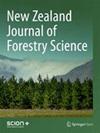传统的普通最小二乘回归与三种利用辐射松样本增强生物量方程可加性的方法的比较
IF 1.1
4区 农林科学
Q2 FORESTRY
引用次数: 1
摘要
背景:可加性长期以来一直被认为是预测组成部分和整棵树生物量的方程系统的理想性质。然而,大多数树木生物量研究报告使用传统的普通最小二乘回归拟合生物量方程。因此,我们旨在利用传统的线性和非线性普通最小二乘回归模型来估算辐射松生物量数据集的成分、小计和地上总生物量,并将这些方程与生物量估算的加性过程进行比较。方法:采伐24棵10年树龄树木,评估其地上生物量。生物质建模实施了两个广泛的程序:(a)独立;(b)添加剂。对于独立过程,比较了具有比例幂变换和y截距的传统线性模型(LINOLS)和没有y截距的非线性幂模型(NLINOLS)。在三种不同的加性结构(LINADD1、LINADD2和LINADD3)中进一步测试了独立过程中获得的最佳线性(转换)模型。所有模型均采用拟合优度统计、估计的标准误差和残差图进行评估。结果:与缺乏y截距的NLINOLS相比,具有比例功率转换和y截距的LINOLS在所有成分、小计和地上总生物量方面表现更好。与其他方法相比,联合广义线性最小二乘回归(也称为看似无关回归(SUR))中的加性模型(LINADD3)提供了6个成分(茎、枝、新叶和旧叶)中的4个成分(茎、枝、新叶和旧叶)、3个小计(叶和冠)中的2个成分和地上总生物量的最佳拟合优度统计和残差图。而LINOLS方法对树皮、球果和孔洞生物量的预测效果较好。结论:SUR是预测24棵树数据集生物量的最佳方法,因为它提供了最佳的拟合优度统计,对10个生物量成分中的7个进行了无偏估计。这项研究可以帮助林业工作者和森林管理者克服在使用独立拟合的生物量方程时的一个主要问题,即预测的树木成分的生物量总和不一定加到总生物量中,而加性生物量模型则这样做。本文章由计算机程序翻译,如有差异,请以英文原文为准。
A comparison between traditional ordinary least-squares regression and three methods for enforcing additivity in biomass equations using a sample of Pinus radiata trees
Background: Additivity has long been recognised as a desirable property of systems of equations to predict the biomass of components and the whole tree. However, most tree biomass studies report biomass equations fitted using traditional ordinary least-squares regression. Therefore, we aimed to develop models to estimate components, subtotals and above-ground total biomass for a Pinus radiata D.Don biomass dataset using traditional linear and nonlinear ordinary leastsquares regressions, and to contrast these equations with the additive procedures of biomass estimation.Methods: A total of 24 ten-year-old trees were felled to assess above-ground biomass. Two broad procedures were implemented for biomass modelling: (a) independent; and (b) additive. For the independent procedure, traditional linear models (LINOLS) with scaled power transformations and y-intercepts and nonlinear power models (NLINOLS) without y-intercepts were compared. The best linear (transformed) models from the independent procedure were further tested in three different additive structures (LINADD1, LINADD2, and LINADD3). All models were evaluated using goodness-of-fit statistics, standard errors of estimates, and residual plots.Results: The LINOLS with scaled power transformations and y-intercepts performed better for all components, subtotals and total above-ground biomass in contrast to NLINOLS that lacked y-intercepts. The additive model (LINADD3) in a joint generalised linear least-squares regression, also called seemingly unrelated regression (SUR), provided the best goodness-of-fit statistics and residual plots for four out of six components (stem, branch, new foliage and old foliage), two out of three subtotals (foliage and crown), and above-ground total biomass compared to other methods. However, bark, cone and bole biomass were better predicted by the LINOLS method.Conclusions: SUR was the best method to predict biomass for the 24-tree dataset because it provided the best goodness-of-fit statistics with unbiased estimates for 7 out of 10 biomass components. This study may assist silviculturists and forest managers to overcome one of the main problems when using biomass equations fitted independently for each tree component, which is that the sum of the biomasses of the predicted tree components does not necessarily add to the total biomass, as the additive biomass models do.
求助全文
通过发布文献求助,成功后即可免费获取论文全文。
去求助
来源期刊

New Zealand Journal of Forestry Science
FORESTRY-
CiteScore
2.20
自引率
13.30%
发文量
20
审稿时长
39 weeks
期刊介绍:
The New Zealand Journal of Forestry Science is an international journal covering the breadth of forestry science. Planted forests are a particular focus but manuscripts on a wide range of forestry topics will also be considered. The journal''s scope covers forestry species, which are those capable of reaching at least five metres in height at maturity in the place they are located, but not grown or managed primarily for fruit or nut production.
 求助内容:
求助内容: 应助结果提醒方式:
应助结果提醒方式:


